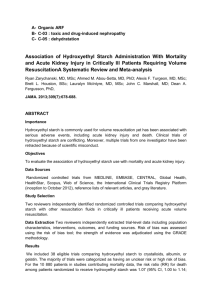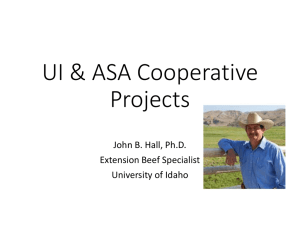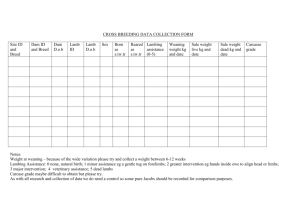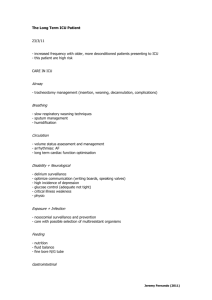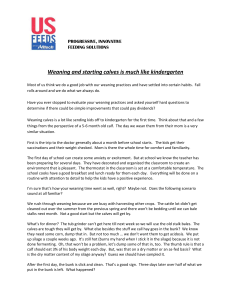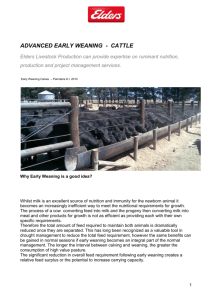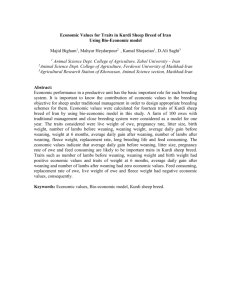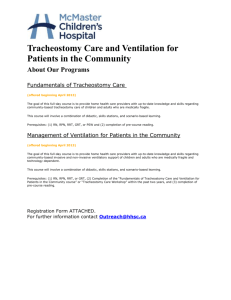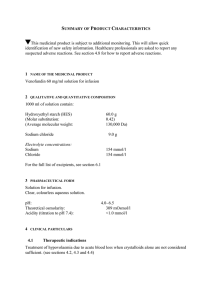Effect of Pressure Support vs Unassisted Breathing
advertisement
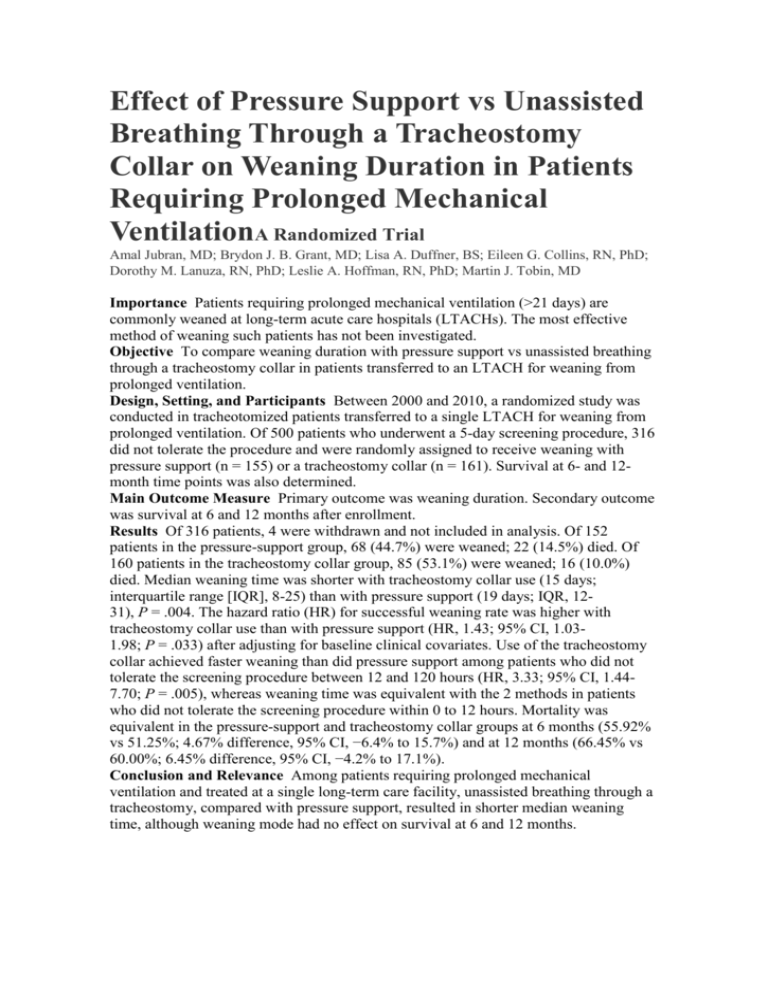
Effect of Pressure Support vs Unassisted Breathing Through a Tracheostomy Collar on Weaning Duration in Patients Requiring Prolonged Mechanical VentilationA Randomized Trial Amal Jubran, MD; Brydon J. B. Grant, MD; Lisa A. Duffner, BS; Eileen G. Collins, RN, PhD; Dorothy M. Lanuza, RN, PhD; Leslie A. Hoffman, RN, PhD; Martin J. Tobin, MD Importance Patients requiring prolonged mechanical ventilation (>21 days) are commonly weaned at long-term acute care hospitals (LTACHs). The most effective method of weaning such patients has not been investigated. Objective To compare weaning duration with pressure support vs unassisted breathing through a tracheostomy collar in patients transferred to an LTACH for weaning from prolonged ventilation. Design, Setting, and Participants Between 2000 and 2010, a randomized study was conducted in tracheotomized patients transferred to a single LTACH for weaning from prolonged ventilation. Of 500 patients who underwent a 5-day screening procedure, 316 did not tolerate the procedure and were randomly assigned to receive weaning with pressure support (n = 155) or a tracheostomy collar (n = 161). Survival at 6- and 12month time points was also determined. Main Outcome Measure Primary outcome was weaning duration. Secondary outcome was survival at 6 and 12 months after enrollment. Results Of 316 patients, 4 were withdrawn and not included in analysis. Of 152 patients in the pressure-support group, 68 (44.7%) were weaned; 22 (14.5%) died. Of 160 patients in the tracheostomy collar group, 85 (53.1%) were weaned; 16 (10.0%) died. Median weaning time was shorter with tracheostomy collar use (15 days; interquartile range [IQR], 8-25) than with pressure support (19 days; IQR, 1231), P = .004. The hazard ratio (HR) for successful weaning rate was higher with tracheostomy collar use than with pressure support (HR, 1.43; 95% CI, 1.031.98; P = .033) after adjusting for baseline clinical covariates. Use of the tracheostomy collar achieved faster weaning than did pressure support among patients who did not tolerate the screening procedure between 12 and 120 hours (HR, 3.33; 95% CI, 1.447.70; P = .005), whereas weaning time was equivalent with the 2 methods in patients who did not tolerate the screening procedure within 0 to 12 hours. Mortality was equivalent in the pressure-support and tracheostomy collar groups at 6 months (55.92% vs 51.25%; 4.67% difference, 95% CI, −6.4% to 15.7%) and at 12 months (66.45% vs 60.00%; 6.45% difference, 95% CI, −4.2% to 17.1%). Conclusion and Relevance Among patients requiring prolonged mechanical ventilation and treated at a single long-term care facility, unassisted breathing through a tracheostomy, compared with pressure support, resulted in shorter median weaning time, although weaning mode had no effect on survival at 6 and 12 months. Association of Hydroxyethyl Starch Administration With Mortality and Acute Kidney Injury in Critically Ill Patients Requiring Volume ResuscitationA Systematic Review and Meta-analysis Ryan Zarychanski, MD, MSc; Ahmed M. Abou-Setta, MD, PhD; Alexis F. Turgeon, MD, MSc; Brett L. Houston, BSc; Lauralyn McIntyre, MD, MSc; John C. Marshall, MD; Dean A. Fergusson, PhD, MHA JAMA. 2013;309(7):678-688. doi:10.1001/jama.2013.430. Importance Hydroxyethyl starch is commonly used for volume resuscitation yet has been associated with serious adverse events, including acute kidney injury and death. Clinical trials of hydroxyethyl starch are conflicting. Moreover, multiple trials from one investigator have been retracted because of scientific misconduct. Objectives To evaluate the association of hydroxyethyl starch use with mortality and acute kidney injury. Data Sources Randomized controlled trials from MEDLINE, EMBASE, CENTRAL, Global Health, HealthStar, Scopus, Web of Science, the International Clinical Trials Registry Platform (inception to October 2012), reference lists of relevant articles, and gray literature. Study Selection Two reviewers independently identified randomized controlled trials comparing hydroxyethyl starch with other resuscitation fluids in critically ill patients receiving acute volume resuscitation. Data Extraction Two reviewers independently extracted trial-level data including population characteristics, interventions, outcomes, and funding sources. Risk of bias was assessed using the risk of bias tool; the strength of evidence was adjudicated using the GRADE methodology. Results We included 38 eligible trials comparing hydroxyethyl starch to crystalloids, albumin, or gelatin. The majority of trials were categorized as having an unclear risk or high risk of bias. For the 10 880 patients in studies contributing mortality data, the risk ratio (RR) for death among patients randomized to receive hydroxyethyl starch was 1.07 (95% CI, 1.00 to 1.14; I2, 0%; absolute risk [AR], 1.20%; 95% CI, −0.26% to 2.66%). This summary effect measure included results from 7 trials performed by an investigator whose subsequent research had been retracted because of scientific misconduct. When we excluded these 7 trials that involved 590 patients, hydroxyethyl starch was found to be associated with increased mortality among 10 290 patients (RR, 1.09; 95% CI, 1.02 to 1.17; I2, 0%; AR, 1.51%; 95% CI, 0.02% to 3.00%), increased renal failure among 8725 patients (RR, 1.27; 95% CI, 1.09 to 1.47; I2, 26%; AR, 5.45%; 95% CI, 0.44% to 10.47%), and increased use of renal replacement therapy among 9258 patients (RR, 1.32; 95% CI, 1.15 to 1.50; I2, 0%; AR, 3.12%; 95% CI, 0.47% to 5.78%). Conclusion and Relevance In critically ill patients requiring acute volume resuscitation, use of hydroxyethyl starch compared with other resuscitation solutions was not associated with a decrease in mortality. Moreover, after exclusion of 7 trials performed by an investigator whose research has been retracted because of scientific misconduct, hydroxyethyl starch was associated with a significant increased risk of mortality and acute kidney injury. Clinical use of hydroxyethyl starch for acute volume resuscitation is not warranted due to serious safety concern
